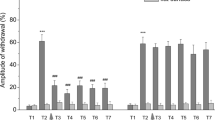Abstract
Neurophysiological mechanisms responsible for generalized and signal-specific long-term (longer than 24 h) nociceptive sensitizations were studied in theHelix command neurons of defensive behavior. After a one-day acquisition, the manifestations of the signal-specific sensitization were predominant. These included the site and modal specificities. The former was manifested in a predominant synaptic facilitation of the responses to testing stimulation of the same body areas to which the sensitizing stimulation was applied, compared with stimulation of other body areas. The latter was manifested as a more expressed facilitation of the responses to testing stimulation of sensory modality similar to the sensitizing one, compared with the facilitation of the responses to testing stimulations of other sensory modalities. A three-day acquisition resulted in a predominance of the generalized sensitization signs: a clear non-selective facilitation of the responses to activation of all synaptic inputs, together with depolarization and increased excitability of the command neurons.
Similar content being viewed by others
References
J. H. Byrne, “Cellular analysis of associative learning,”Physiol. Rev.,67, No. 2, 329–439 (1987).
R. D. Hawkins, E. R. Kandel, and S. A. Siegelbaum, “Learning to modulate transmitter release: themes and variations in synaptic plasticity,”Annu. Rev. Neurosci.,16, 625–665 (1993).
E. T. Walters, “A functional, cellular, and evolutionary model of nociceptive plasticity inAplysia,”Biol. Bull.,180, No. 2, 400–407 (1991).
E. T. Walters, “Site-specific sensitization of defensive reflexes inAplysia: a simple model of long-term hyperalgesia,”J. Neurosci.,7, No. 2, 400–407 (1987).
L.-E. Trudeau and V. F. Castellucci, “Contribution of polysynaptic pathways in the mediation and plasticity ofAplysia gill and siphon withdrawal reflex: evidence for differential modulation,”J. Neurosci.,12, No. 10, 3838–3848 (1992).
A. Billy and E. T. Walters, “Long-term expansion and sensitization of mechanosensory receptive fields inAplysia support an activity-dependent model of whole-cell sensory plasticity,”J. Neurosci.,9, No. 4, 1254–1262 (1989).
E. T. Walters, “Transformation of siphon responses during conditioning ofAplysia suggested a model of primitive stimulus-response association,”Proc. Natl. Acad. Sci. USA,86, 7616–7619 (1989).
O. A. Maksimova and P. M. Balaban,Neuronal Mechanisms of Behavioral Plasticity [in Russian], Nauka, Moscow (1983).
V. P. Nikitin and S. A. Kozyrev, “Dynamics of defensive and food reactions observed during the elaboration of sensitization inHelix pomatia,”Zh. Vyssh. Nerv. Deyat.,41, No. 3, 478–489 (1991).
V. P. Nikitin, S. A. Kozyrev, and M. O. Samoilov, “Involvement of intracellular calcium in the process of sensitization inHelix pomatia neurons of defensive behavior,”Neirofiziologiya,23, No. 4, 418–427 (1991).
D. B. Logunov, “Correlation of fast and slow elementary synaptic potentials inHelix pomatia command neurons,”Zh. Vyssh. Nerv. Deyat.,33, No. 2, 355–362 (1983).
V. P. Nikitin and S. A. Kozyrev, “Effects of protein synthesis inhibitors on neural mechanisms of sensitization inHelix snail,”Neirofiziologiya/Neurophysiology,1, No. 2, 109–115 (1993).
V. D. Goncharuk, S. A. Kosyrev, and V. P. Nikitin, “Sensitization inHelix snail: morphofunctional correlates in command neurons of withdrawal behavior,”Neirofiziologiya/Neurophysiology,1, No. 2, 150–157 (1993).
V. P. Nikitin and S. A. Kozyrev, “Learning-related long-term synaptic facilitation in snail: possible mechanisms of long-term memory formation,”Neirofiziologiya/Neurophysiology,1, No. 5, 383–389 (1993).
H. P. Davis and L. R. Squire, “Protein synthesis and memory: A review,”Psychol. Bull.,96, No. 3, 518–558 (1984).
N. A. Beregovoi and Kh. L. Gainutdinov, “The depolarizing shifts of membrane potential inHelix neurons of defensive behavior accompanying a long-term sensitization,”Dokl. Akad. Nauk SSSR,301, No. 4, 989–992 (1988).
Kh. L. Gainutdinov, “Bioelectrical (membrane) mechanisms responsible for the antibodies-induced induction of a pathological enhanced excitation during the development of neuroimmune processes,”Abstr. of Doctoral Thesis, Biol Sci. [in Russian], Novosibirsk (1994).
Author information
Authors and Affiliations
Additional information
Neirofiziologiya/Neurophysiology, Vol. 27, No. 1, pp. 45–53, January–February, 1995.
Rights and permissions
About this article
Cite this article
Nikitin, V.P., Kozyrev, S.A. Neurophysiological mechanisms of generalized and signal-specific long-term nociceptive sensitizations in theHelix snail. Neurophysiology 27, 35–41 (1995). https://doi.org/10.1007/BF01054565
Received:
Issue Date:
DOI: https://doi.org/10.1007/BF01054565



